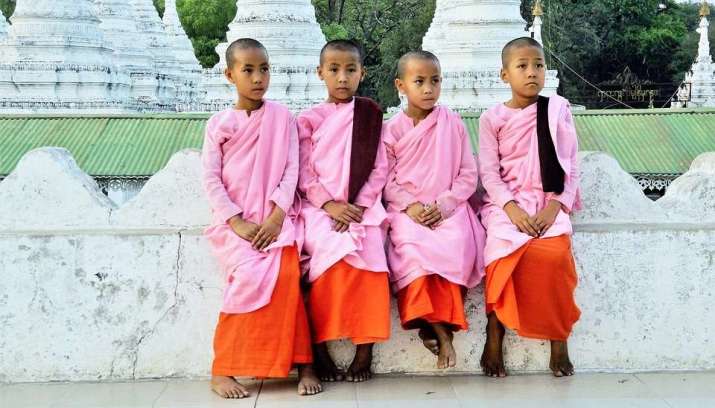
In The Four Sublime States: Contemplations on Love, Compassion, Sympathetic Joy and Equanimity, Nyanaponika Maha Thera begins:
Four sublime states of mind have been taught by the Buddha:
Love or Loving-kindness (Pali: metta)
Compassion (Pali: karuna)
Sympathetic Joy (Pali: mudita)
Equanimity (Pali: upekkha)
In Pali . . . these four are known under the name of Brahma-vihara. This term may be rendered by: excellent, lofty, or sublime states of mind; or alternatively by: Brahma-like, god-like, or divine abodes.
These four attitudes are said to be excellent or sublime because they are the right or ideal way of conduct toward living beings (Pali: sattesu samma patipatti). They provide . . . the answer to all situations arising from social contact. They are the great removers of tension, the great peacemakers in social conflict, and the great healers of wounds suffered in the struggle of existence. They level social barriers, build harmonious communities, awaken slumbering magnanimity long forgotten, revive joy and hope long abandoned, and promote human brotherhood against the forces of egotism.
The Brahma-viharas are incompatible with a hating state of mind, and in that they are akin to Brahma . . . Brahma is free from hate; and one who assiduously develops these four sublime states, by conduct and meditation, is said to become an equal of Brahma (Pali: brahma-samo). If they become the dominant influence in his mind, he will be reborn in congenial worlds, the realms of Brahma. Therefore, these states of mind are called God-like, Brahma-like.
They are called abodes (Pali: vihara) because they should become the mind’s constant dwelling-places where we feel “at home;” they should not remain merely places of rare and short visits, soon forgotten. In other words, our minds should become thoroughly saturated by them. They should become our inseparable companions, and we should be mindful of them in all our common activities.
As the Metta Sutta, the Song of Loving-kindness, says:
When standing, walking, sitting, lying down,
Whenever he feels free of tiredness
Let him establish well this mindfulness—
This, it is said, is the Divine Abode. (Nyanaponika 1, 1994)
Love, compassion, sympathetic joy, and equanimity are also known as the boundless states (Pali: appamanna), because, in their perfection and their true nature, they should not be narrowed by any limitation as to the range of beings toward whom they are extended. They should be non-exclusive and impartial, not bound by selective preferences or prejudices. A mind that has attained that boundlessness of the Brahma-viharas will not harbor any national, racial, religious, or class hatred.
But unless rooted in a strong natural affinity with such a mental attitude, it will certainly not be easy for us to effect that boundless application by a deliberate effort of will and to consistently avoid any kind or degree of partiality.
To achieve that, in most cases, we shall have to use these four qualities not only as principles of conduct and objects of reflection, but also as subjects of methodical meditation. That meditation is called Brahma-vihara Bhavana, the meditative development of the sublime states. The practical aim is to achieve, with the help of these sublime states, those high stages of mental concentration called jhana, “meditative absorption.” The meditations on love, compassion, and sympathetic joy may each produce the attainment of the first three absorptions, while the meditation on equanimity will lead to the fourth jhana only, in which equanimity is the most significant factor.
Generally speaking, persistent meditative practice will have two crowning effects: first, it will make these four qualities sink deep into the heart so that they become spontaneous attitudes not easily overthrown; second, it will bring out and secure their boundless extension, the unfolding of their all-embracing range. In fact, the detailed instructions given in the Buddhist scriptures for the practice of these four meditations are clearly intended to unfold gradually the boundlessness of the sublime states. They systematically break down all barriers restricting their application to particular individuals or places.
In the meditative exercises, the selection of people to whom the thought of love, compassion, or sympathetic joy is directed proceeds from the easier to the more difficult. For instance, when meditating on loving-kindness, one starts with an aspiration for one’s own well-being, using it as a point of reference for gradual extension:
“Just as I wish to be happy and free from suffering, so may that being, may all beings be happy and free from suffering!”
Then one extends the thought of loving-kindness to a person for whom one has a loving respect, as, for instance, a teacher; then to dearly beloved people, to indifferent ones, and finally to enemies, if any, or those disliked. Since this meditation is concerned with the welfare of the living, one should not choose people who have died; one should also avoid choosing people toward whom one may have feelings of sexual attraction. (Nyanaponika 2, 1994)
After one has been able to cope with the hardest task, to direct one’s thoughts of loving-kindness to disagreeable people, one should now “break down the barriers” (Pali: sima-sambheda). Without making any discrimination between those four types of people, one should extend one’s loving-kindness to them equally. At that point of the practice one will have come to the higher stages of concentration: with the appearance of the mental reflex-image (Pali: patibhaganimitta), access concentration (Pali: upacara samadhi) will have been reached, and further progress will lead to the full concentration (Pali: appana) of the first jhana, then the higher jhanas.
For spatial expansion, the practice starts with those in one’s immediate environment such as one’s family, then extends to the neighboring houses, to the whole street, the town, country, other countries, and the entire world. In “pervasion of the directions,” one’s thought of loving-kindness is directed first to the east, then to the west, north, south, the intermediate directions, the zenith and nadir.
The same principles of practice apply to the meditative development of compassion, sympathetic joy and equanimity, with due variations in the selection of people. Details of the practice will be found in the texts. (See Visuddhimagga, Chapter IX)
The ultimate aim of attaining these Brahma-vihara jhanas is to produce a state of mind that can serve as a firm basis for the liberating insight into the true nature of all phenomena as being impermanent, liable to suffering, and unsubstantial. A mind that has achieved meditative absorption induced by the sublime states will be pure, tranquil, firm, collected, and free of coarse selfishness. It will thus be well prepared for the final work of deliverance, which can be completed only by insight.
Meditative development of the sublime states will be aided by repeated reflection on their qualities, the benefits they bestow, and the dangers from their opposites. As the Buddha says, “What a person considers and reflects on for a long time, to that his mind will bend and incline.” (Nyanaponika 3, 1994)
References
Nyanaponika Thera. 1994. The Four Sublime States: Contemplations on Love, Compassion, Sympathetic Joy and Equanimity. Kandy: Buddhist Publication Society.














